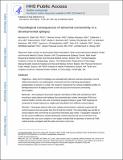Physiological consequences of abnormal connectivity in a developmental epilepsy
Author(s)
Shafi, Mouhsin M.; Vernet, Marine; Klooster, Debby; Chu, Catherine J.; Boric, Katica; Barnard, Mollie E.; Romatoski, Kelsey; Westover, M. Brandon; Christodoulou, Joanna A.; Gabrieli, John D. E.; Whitfield-Gabrieli, Susan; Pascual-Leone, Alvaro; Chang, Bernard S.; ... Show more Show less
Downloadnihms-652594.pdf (1.484Mb)
OPEN_ACCESS_POLICY
Open Access Policy
Creative Commons Attribution-Noncommercial-Share Alike
Terms of use
Metadata
Show full item recordAbstract
Objective
Many forms of epilepsy are associated with aberrant neuronal connections, but the relationship between such pathological connectivity and the underlying physiological predisposition to seizures is unclear. We sought to characterize the cortical excitability profile of a developmental form of epilepsy known to have structural and functional connectivity abnormalities.
Methods
We employed transcranial magnetic stimulation (TMS) with simultaneous electroencephalographic (EEG) recording in 8 patients with epilepsy from periventricular nodular heterotopia and matched healthy controls. We used connectivity imaging findings to guide TMS targeting and compared the evoked responses to single-pulse stimulation from different cortical regions.
Results
Heterotopia patients with active epilepsy demonstrated a relatively augmented late cortical response that was greater than that of matched controls. This abnormality was specific to cortical regions with connectivity to subcortical heterotopic gray matter. Topographic mapping of the late response differences showed distributed cortical networks that were not limited to the stimulation site, and source analysis in 1 subject revealed that the generator of abnormal TMS-evoked activity overlapped with the spike and seizure onset zone.
Interpretation
Our findings indicate that patients with epilepsy from gray matter heterotopia have altered cortical physiology consistent with hyperexcitability, and that this abnormality is specifically linked to the presence of aberrant connectivity. These results support the idea that TMS-EEG could be a useful biomarker in epilepsy in gray matter heterotopia, expand our understanding of circuit mechanisms of epileptogenesis, and have potential implications for therapeutic neuromodulation in similar epileptic conditions associated with deep lesions.
Date issued
2015-02Department
Massachusetts Institute of Technology. Department of Brain and Cognitive Sciences; McGovern Institute for Brain Research at MITJournal
Annals of Neurology
Publisher
Wiley Blackwell
Citation
Shafi, Mouhsin M. et al. “Physiological Consequences of Abnormal Connectivity in a Developmental Epilepsy.” Annals of Neurology 77, 3 (January 2015): 487–503 © 2015 American Neurological Association
Version: Author's final manuscript
ISSN
0364-5134
1531-8249